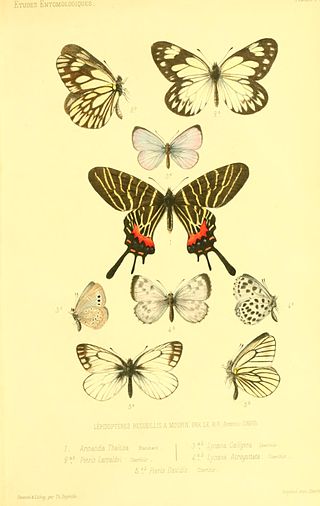
Syringa is a genus of 12 currently recognized species of flowering woody plants in the olive family or Oleaceae called lilacs. These lilacs are native to woodland and scrub from southeastern Europe to eastern Asia, and widely and commonly cultivated in temperate areas elsewhere.

The Pieridae are a large family of butterflies with about 76 genera containing about 1,100 species, mostly from tropical Africa and tropical Asia with some varieties in the more northern regions of North America and Eurasia. Most pierid butterflies are white, yellow, or orange in coloration, often with black spots. The pigments that give the distinct coloring to these butterflies are derived from waste products in the body and are a characteristic of this family. The family was created by William John Swainson in 1820.

Papilio is a genus in the swallowtail butterfly family, Papilionidae, as well as the only representative of the tribe Papilionini. The word papilio is Latin for butterfly.

Pieris, the whites or garden whites, is a widespread, now almost cosmopolitan, genus of butterflies of the family Pieridae. The highest species diversity is in the Palearctic, with a higher diversity in Europe and eastern North America than the similar and closely related Pontia. The females of many Pieris butterflies are UV reflecting, while the male wings are strongly UV absorbing due to pigments in the scales.

The Heliconiinae, commonly called heliconians or longwings, are a subfamily of the brush-footed butterflies. They can be divided into 45–50 genera and were sometimes treated as a separate family Heliconiidae within the Papilionoidea. The colouration is predominantly reddish and black, and though of varying wing shape, the forewings are always elongated tipwards, hence the common name.

Colias is a genus of butterflies in the family Pieridae. They are often called clouded yellows in the Palearctic and sulphurs in North America. The closest living relative is the genus Zerene, which is sometimes included in Colias.

Boloria is a brush-footed butterfly (Nymphalidae) genus. Clossiana is usually included with it nowadays, though some authors still consider it distinct and it seems to warrant recognition as a subgenus at least.

Pontia edusa, the eastern Bath white, is a butterfly in the family Pieridae.

Sinopieris is a genus of butterflies in the family Pieridae. The genus occurs in Gansu, Nepal, Nanshan, Shaanxi, Sichuan, Tibet and Yunnan. All six species were originally included in Pieris and subsequently in Pontia.

Sinopieris davidis is a species of butterfly in the genus Sinopieris, but also possibly in Pontia. It was described by Charles Oberthür in 1876 and is found in China.
Sinopieris dubernardi, or Oberthür's white, is a species of butterfly in the family Pieridae. It is treated as a member of the genus Sinopieris, or alternately, the genus Pontia. It is found in China, where it inhabits grassland plateaus and mountainsides at elevations above 2,000 meters.









